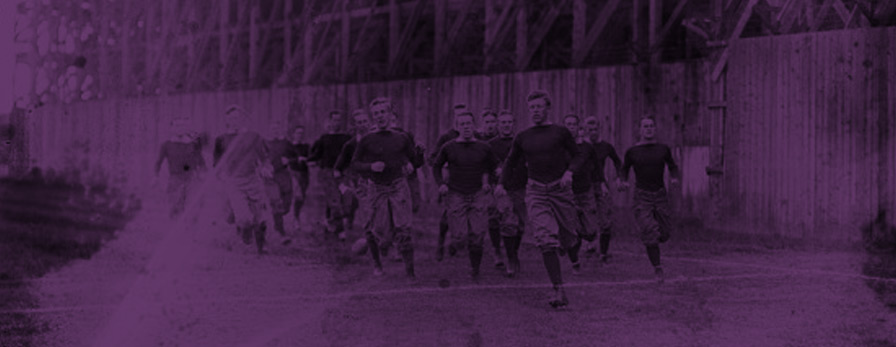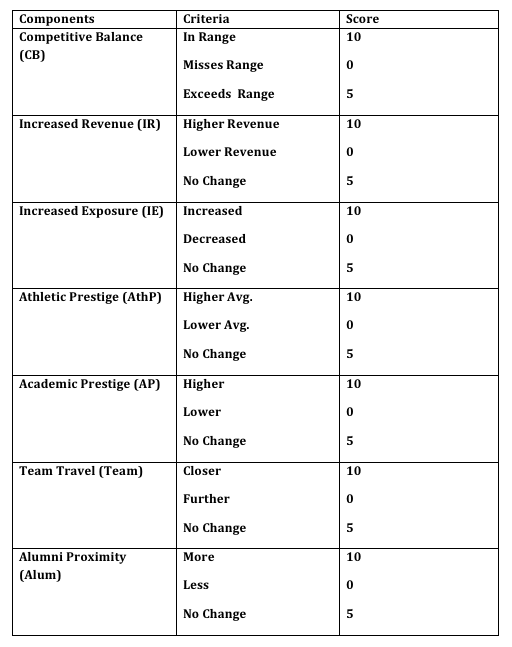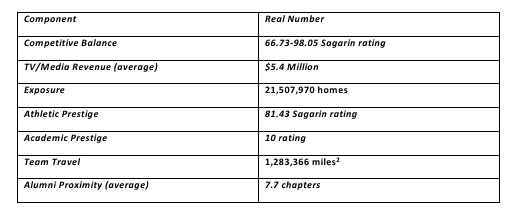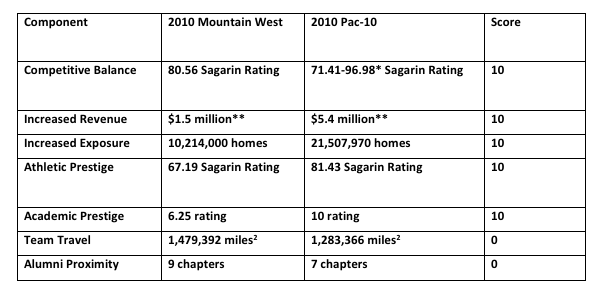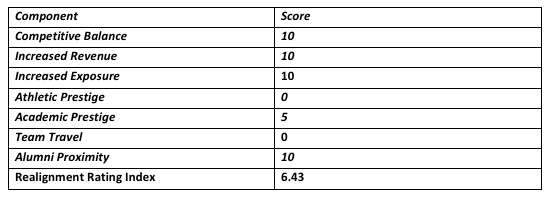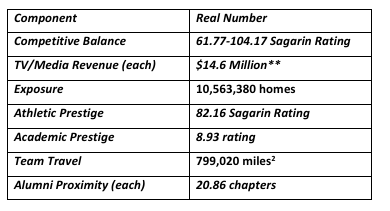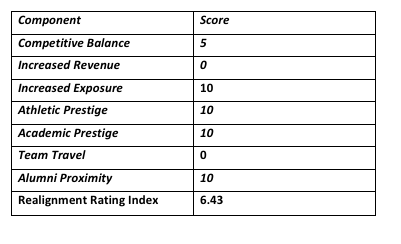By: G.K. Nwosu
When Presidents and Trustees, together with Commissioners and Athletic Directors, are evaluating conference realignment, there are a myriad of factors to consider. Over nearly two decades, beginning in 1990, approximately 30 institutions switched their conference affiliations. 1 This period witnessed Arkansas and South Carolina joining the Southeastern Conference, Penn State to the Big Ten, Florida State to the Atlantic Coast Conference, the formation of new conferences such as the Big 12 and the Mountain West, and three institutions defecting from the Big East for the ACC—an exodus that may have laid the foundation for the current and rapid state of conference realignment in intercollegiate athletics. As a lens for viewing both the micro and macro level considerations to quantify and assess institutions’ moves in this era, we offer a framework of seven components:
- Competitive Balance
- Increased Revenue
- Increased Exposure
- Athletic Prestige
- Academic Prestige
- Team Travel
- Alumni Proximity
Below we explain these seven components (Part I) and then we apply them to two conferences that have made recent additions: The Pac-12 and the SEC. An analysis of selected moving institutions will demonstrate the model’s practical application which can be leveraged through communications strategy (Parts II and IV). An analysis will also be utilized to gain perspective on each of the two conferences relative to realignment (Parts III and V). Part VI concludes this study on conference realignment by providing certain measures and caveats that may be addressed, going forward, during practical application and research.
Part I – The Seven Components of the Realignment Rating Index
Competitive Balance serves as a measure to quantify the athletic strength of each of the member institutions within the conference. This is used to measure how incoming members may fit into their new conference between the lines of play as derived from sports statistician Jeff Sagarin and his Sagarin Rating. A range is determined for competitive balance within the conference, pre-realignment. New members’ individual Competitive Balance score is compared against the range to determine if the fit provides overall balance for the conference. If the member exceeds the range, a corresponding score is awarded. If the member fails to reach the cutoff of the said range, another corresponding score is awarded.
Increased Revenue is measured utilizing financial data relative to a conferences’ television/media agreement. An increase, decrease, or no change in the average individual share of television/media revenue warrants corresponding scores.
Increased Exposure is an extension of the Increased Revenue component. We have utilized this to assess the television market footprint an institution/conference may hold. Similar scoring applies where a score associated with an improvement, a digression, or no change is awarded. In acquiring Increased Exposure data, attention is paid to include the largest television/media market served. For example, Boulder, Colorado is the home of the University of Colorado. That market is relatively small compared to the Denver, Colorado market in which the university’s footprint extends. The Denver television market ranks 17th in the country so that market is utilized for analysis.
Athletic Prestige measures a conference’s overall strength again using the Sagarin Rating. This should not be confused with Competitive Balance as the Athletic Prestige component is an aggregate indicator of strength while Competitive Balance measures any disparities between institutions.
Academic Prestige The increase, decrease, no change scoring model is once again implemented for Academic Prestige. This is similar to Athletic prestige in that it measures the conference’s overall strength, but relative to its academic and research pursuits. Data is compiled from the Carnegie Classification of Institutions of Higher Education. 2 A conference whose academic profile has increased, decreased or has remained the same is awarded a corresponding score.
Team Travel measures the overall geographic footprint in square miles covered by a particular conference once factoring old, current, or new/incoming member institutions.
Alumni Proximity is utilized to determine how many alumni chapters each member institution claims in the states of other conference member institutions. In theory, an institution considering whether to accept invitation to a new conference should analyze the gap that can be bridged relative to alumni contact. Conference members should also analyze alumni connections they serve to gain in new member institutions.
Realignment Rating Index Formula Parameters
Part II – Realignment Rating Index Applied (Utah and Colorado)
It has been argued that the latest wave of conference realignment began in the summer of 2010 when the University of Utah and the University of Colorado officially accepted invitations to join the expanding Pac-10. 3 What has happened since has been a veritable domino effect that has spanned the country from the mid-major conferences to the power conferences. Part II analyzes the Pac-12 before and after the additions of Utah and Colorado. Table 1depicts the then Pac-10 at the completion of the 2010 football season.
Table 1- Pac-10 Conference, 2010
The acquisition of Utah has been described as driven by strategic positioning for the Pac-12. The conference added an institution that had been a highly competitive and successful football program in the Mountain West Conference. The school had won its conference’s football crown four times and was the first “BCS Buster” when it qualified for, and won, the 2005 Fiesta Bowl. Its 2010 Sagarin rating of 80.56 indicated that it could compete with its new West Coast brethren.
Utah was also faced with the prospect of a significant payday through the television/media agreement that Pac-12 was set to negotiate. Even under the existing Pac-10 agreement in 2010, Utah was presented with the opportunity to nearly quintuple its television/media revenue. Utah was able to expand its footprint across the West Coast and with a conference much stronger than the Mountain West. In doing so, the school could claim exposure to four of the nation’s top 12 television markets and approximately 21.5 million television viewing households overall. Utah would also bring with it the Salt Lake City television market, the nation’s 32nd ranked market, which enabled its new conference to also extend its footprint. 4
Additionally, the move put Utah in the company of some of the nation’s elite academic conferences while increasing the area in square miles Utah would be responsible for navigating due to athletic competition. The expansion allowed the University to cultivate relationships through athletics with alumni groups in previously unaddressed locations. Utilizing the parameters of the Realignment Rating Index, we can objectively assess Utah’s move from the Mountain West to the Pac-10.
Table 2- Utah Comparison, 2010
*Denotes adjusted range 5
*Estimated bassed on complied conference data
Remembering the Realignment Rating Index formula of:
(CB+IR+IE+AthP+AP+Team+Alum)/7
and inputting the above values, Utah’s RRI score is 7.14. Keep in mind that a score of 10 represents complete benefit across all the fields of the Index.
As mentioned previously, the University of Colorado was paired with Utah in order to increase the Pac-10’s membership to 12 institutions. Another strategic acquisition, Colorado’s 2010 Competitive Balance score of 68.82 in football projected that it may struggle between the lines on the field of play. Although Colorado left a league that was providing its members, on average, with $15 million in TV/media revenue for one that was providing about a third of that, the negotiations in which the Pac-12 were engaged at the time with ESPN, Fox Sports, and its own network may have strongly influenced Colorado in this regard.
As a member of the Big 12, Colorado enjoyed a footprint that extended to nearly 14 million homes and also claimed six top 50 television markets in the United States. Joining their new league would extend their exposure by nearly 8 million homes and would also give the Pac-12 access to another 1,572,740 television viewing homes. The number signifies the 17thlargest television market in the country. At the conclusion of the 2010 college football season, the Big 12 held and Athletic Prestige ranking of 75.64 while the Pac-10 boasted a ranking 81.43. The Pac-10 appeared to be very much a desirable conference on the rise with two newly minted contenders Stanford and Oregon on the top and a cluster of institutions maintaining solid footing in the Pac-10’s second tier. The Big 12 appeared to be more highly stratified in comparison.
In moving to the Pac-10, Colorado would also be experiencing a higher level of homogeneity as it pertains to the academic pursuits of its new conference neighbors. In switching conferences, team travel was expected to take a hit as Colorado left one conference that spanned over 700,000 square miles for over 1.2 million square miles. Colorado claims at least one alumni chapter in each of the states that comprise the Pac-10.
As a member of the Big 12, the school did not hold any chapters in three conference states. Utilizing the parameters of the Realignment Rating Index, we can utilize an objective assessment of Colorado’s move from the Big-12 to the Pac-10:
Table 3-Colorado Comparison
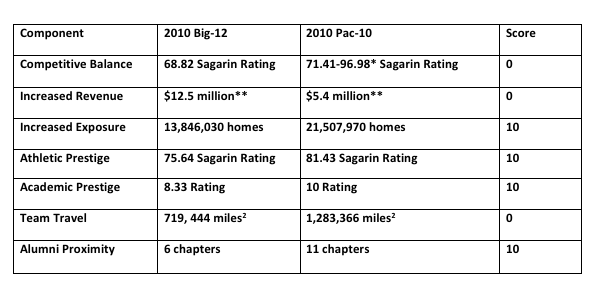 *Denotes adjusted range 6
*Denotes adjusted range 6
Out of the highest achievable score of 10, Colorado checks in with a score of 5.71.
The Realignment Rating Index is designed to provide an objective assessment of an institution’s switch from one conference to another. It is natural to search for a more subjective meaning to such numbers and data, so we postulate that this switch in affiliation enacted by Colorado may have been set into motion for two reasons. First, during the 2010 year, there was plenty of discussion surrounding the Big 12 and possible defection from the likes of Missouri, Nebraska, a number of the Texas schools, and the two Oklahoma schools. 7 Colorado leaving for the Big 12 may have been initiated as a reaction to the landscape as a mechanism for the school’s athletic programs survival. The second reason may have been the institution banking its fortunes on future benefits associated with the soon to be Pac-12 and the $3 billion-plus television/media deal which was in the in the works, the league’s own network, and the additional exposure brought on by the University of Utah to the tune of nearly 1 million television viewing homes 8 (Colorado also has a Salt Lake City alumni chapter).
Part III-The Conference Perspective: The Pac-12
In addition to evaluating conference movement from the individual institution’s perspective, the Realignment Rating Index can also be implemented to analyze a conference as a whole. In this section, we will compare the Pac-10 at the completion of the 2010 football season with the Pac-12 at the completion of its inaugural 2011 football season.
Table 4- Pac-10 Conference, 2010
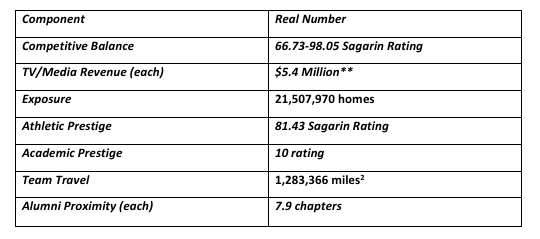 Table 5- Pac-12 Conference, 2011
Table 5- Pac-12 Conference, 2011 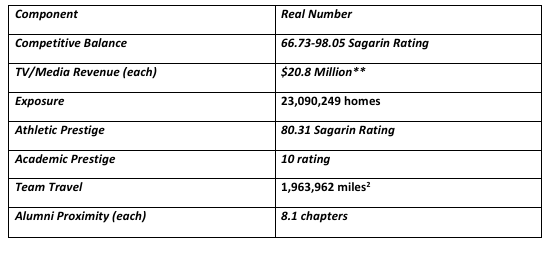 **estimated average based on compiled conference data
**estimated average based on compiled conference data
Table 6- Pac-12 Realignment Rating Index Score
In adding Colorado and Utah, the Pac-12 was able to maintain a competitive distribution across the league. The two new programs, in part helped to leverage the increased television/media revenue as their additions also allowed the league to acquire an additional 1.6 million viewing homes in two top 50 markets. Colorado and Utah did not necessarily increase the league’s football prowess in year one, but the two institutions provide a solid academic fit in line with their new neighbors. Because the Pac-12 now expands much further east into Boulder, considerations towards travel and the student-athlete academic experience is germane. The acquisition also had positive ramifications in terms of bridging the alumni gap as the Pac-12, as a whole, increased institutions’ alumni chapters amongst other member institution’s states.
The conference’s Realignment Rating Index score of 6.43 provides a point of comparison against the RRI itself. A richer comparison can be drawn by analyzing the Pac-12 in context with another conference that recently expanded. Part IV will analyze the University of Missouri, Texas A-&-M, and their move from the Big 12 to the SEC.
Part IV-Realignment Rating Index Applied (Missouri and Texas A-&-M)
As much as Pac-10/Pac-12 expansion is tied to this current round of conference realignment, the Southeastern Conference made an equally notable splash by adding the University of Missouri and Texas A-&-M in time for the start of the 2012-13 year. Using the components of the Realignment Rating Index, let’s review the SEC at the completion of the 2011 football season.
Table 7-Southeastern Conference, 2011 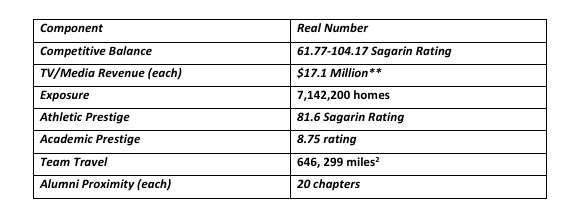
In the University of Missouri, the SEC has added a football program that has transformed into one of the top programs in the Big 12 in recent years. In the highly competitive 2011 edition of the Big 12, Mizzou posted a Sagarin Rating of 85.25 which beat the conference average and has also appeared in seven straight bowl games, winning four. Missouri has direct exposure across the Southeast United States, particularly in two top 30 television markets, Atlanta (9th) and Nashville (29th). The move also places the school amongst institutions that represent a higher academic profile than that of the Big 12 quantified by parameters set forth by the RRI. The move increases the area in square miles to which Missouri would be subjected for team travel. The switch in affiliation also allowed Missouri to nearly double its reach to alumni members via athletics. Again, utilizing the parameters of the Realignment Rating Index, we can utilize an objective assessment of Missouri’s move from the Big 12 to the SEC:
Table 8-Missouri Comparison
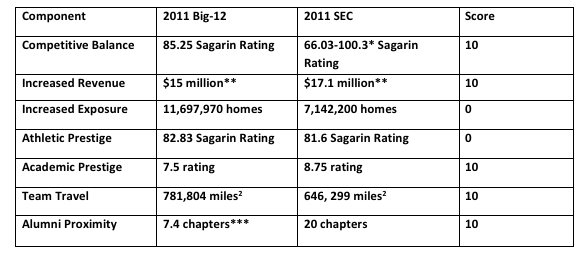
*Denotes adjusted range 9
**estimated average based on compiled conference data
***Baylor University data unavailable
The Realignment Rating Index registers a score of 7.14 for the University of Missouri. The best score that can be achieved via the RRI is a 10. Missouri’s score indicates, preliminarily, that this switch in conference affiliation could be beneficial for the school overall. Next is an analysis of Texas A-&-M to see how the Aggies fare in realigning their membership.
Texas A-&-M football is a program rich in tradition. The school has played in a bowl game nearly every season over the past three decades. Aggie football has experienced its shares of ups and downs over the last decade but seeks new life with a new coaching staff and new conference affiliation for the upcoming season. The Aggies closed out their final year in the Big 12 with an 85.87 Sagarin rating, pitting them in the top half of a highly competitive league. The Big 12 operated with a unique revenue distribution model which recently changed 10 but during A-& -M’s last two years of membership, Big 12 schools earned approximately $12-$15 million, on average, in television/media revenue distribution, a figure that could be trumped once the SEC completes its television/media rights facelift. 11 A-&-M experiences a rabid football viewing fan base not only in College Station (TX), but also in Houston and throughout other areas of the state. This alone may endear the program to the football drenched SEC and vice versa.
A-&-M is classified as a “very high research” institution by the Carnegie Classification of Institutions of Higher Education which, academically, places the school in more homogenous company within the SEC. The Aggies also claim a significantly larger amount of alumni chapters across SEC country than in the Big 12 which may assist in allowing the school to utilize football, and other athletics, as a broad based vehicle for alumni relations. Table 9illustrates a conference comparison per Texas A-&-M:
Table 9-Texas A-&-M Comparison
*Denotes adjusted range 12
**estimated per institution average based on compiled conference data
***Baylor University data unavailable
Texas A-&-M registers an identical RRI score to Missouri at 7.14which again is indicative of a beneficial move for the Aggies in joining the SEC. In Part V, an analysis is provided on the SEC as a conference utilizing the parameters of the Realignment Rating Index.
Part V-The Conference Perspective: The Southeastern Conference
The additions of Missouri and Texas A-&-M provide a solid degree of equity between the lines of play. The football programs bring with them Competitive Balance rankings of 85.25 and 85.87, respectively, squarely placing them in the range of the SEC.
The SEC also acquires two major television markets worth approximately 3.5 million homes in Saint Louis, MO and Houston, TX. These markets rank 10th and 21st respectively and should add a bargaining chip when conference television/media agreements are revamped this year 13
The SEC arguably had two of the best football programs in the nation last season as evidenced by January’s BCS National Championship Game which pitted Alabama against LSU, but overall, the conference was not the nation’s strongest according to the Sagarin ratings. The addition of two football programs that finished in the top 20 of the 2011-12 Sagarin ratings projects to help the league solidify top to bottom football dominance. Missouri and Texas A-&-M also bring strong academics to the SEC which will assist in increasing the league’s academic profile. The conference now spans 799,020 square miles which is approximately 153,000 additional square miles to be accounted for during team travel. The SEC members now claim over 20 alumni chapters across the states that comprise membership.
Table 10-Southeastern Conference, 2012
Table 11- SEC Realignment Rating Index Score
Part VI-Conclusion
By analyzing the two conferences, we offer a view of potential motivations and empirically measured outcomes specific to each should be able to gain a sense of motivations and empirically measured outcomes specific to each conference through realignment. As illustrated by the RRI, the new additions to each conference received or will receive varying levels of benefit through switches in affiliation.
The Realignment Rating Index was designed as a tool to quantitatively and objectively assess individual institutions’ switches in conference affiliations. The metric has been further developed to assess entire conferences upon realignment as illustrated here. There are inherent limitations to the RRI such as it does not provide a qualitative context. Additionally, when the metric is utilized in a predictive state, some value is lost in that some data is projected at best, leaving some room for error. In this write up the RRI does not account for longitudinal data but it is evident that such data may provide a more robust picture for realignment decisions. The metric does not place importance on one component over another. Some institutions or conferences may cite exposure as the driving force in realignment decisions. Such “weighting” is best left to the schools and conference as they see fit.
G.K. Nwosu is a third year doctoral student at the University of Nevada Las Vegas in the Higher Education program. His research area is sports organization behavior specific to intercollegiate athletics. He also hosts a sports business radio program on the university’s station, KUNV 91.5, set to debut this summer. He can be contacted at nwosug@unlv.nevada.edu.
References:
- Benjamin Leibovitz, Avoiding the Sack: How Nebraska’s Departure from the Big 12 Changed College Football and What Athletic Conferences Must do to Prevent Defection in the Future. Marquette Sports Law Review, 22(2), (Spring 2012) 675 694.http://scholarship.law.marquette.edu/cgi/viewcontent.cgi?article=1568&context=sportslaw. ↩
- The Carnegie Classification of Institutions of Higher Education classifies American accredited, degree-granting colleges and universities by research and analysis. The framework was established by the Carnegie Foundation in 1973. ↩
- http://sports.espn.go.com/ncaa/news/story?id=5298238 ↩
- The Nielsen Company, Local Television Market Universe Estimates Comparisons of 2010-11 and 2011-12 Market Ranks (2012), http://www.nielsen.com/content/dam/corporate/us/en/public%20factsheets/tv/nielsen-2012-local-DMA-TV-penetration.pdf. ↩
- Adjusted range is a variation of the Real number range. Adjusted range removes outliers to account for a more accurate and robust distribution. ↩
- See footnote number 4. ↩
- ESPN.com News Services, Texas move helps Big 12 survive, ESPN.com (June 15, 2010), http://sports.espn.go.com http://sports.espn.go.com/ncaa/news/story?id=5286672/ncaa/news/story?id=5286672 ↩
- Ted Miller, Pac 12 announces deal for national, regional networks (July 27,2011), http://espn.go.com/blog/pac12/post/_/id/23602/pac-12-announces-deal-for-national-regional-networks ↩
- see footnote 4 ↩
- Big12sports.com, Big 12 Board of Directors Action, Big12sports.com (October 3,2011), http://www.big12sports.com/ViewArticle.dbml?DB_OEM_ID=10410&ATCLID=205307786 ↩
- Patrick Rihse, ACC’s New $3.6 Billion Television Deal Still Pales in Comparison to Pac-12’s Deal,Forbes.com (May 11, 2012), http://www.forbes.com/sites/prishe/2012/05/11/accs-new-3-6-billion-television-deal-still-pales-in-comparison-to-pac-12s-deal/ ↩
- see footnote number 4 ↩
- Patrick Rihse, ACC’s New $3.6 Billion Television Deal Still Pales in Comparison to Pac-12’s Deal,Forbes.com (May 11, 2012), http://www.forbes.com/sites/prishe/2012/05/11/accs-new-3-6-billion-television-deal-still-pales-in-comparison-to-pac-12s-deal/. ↩

